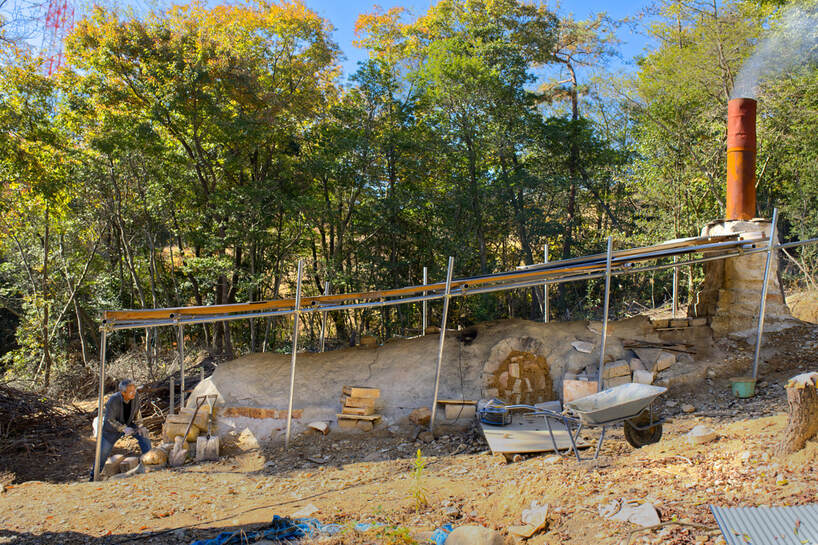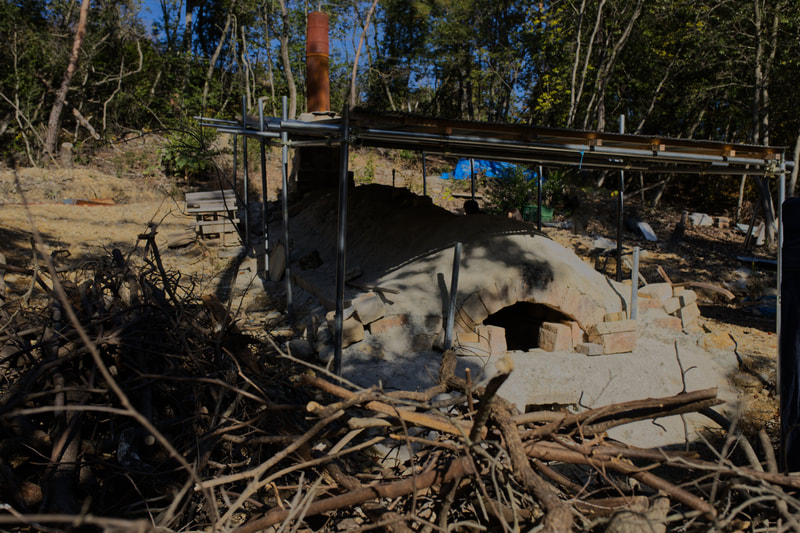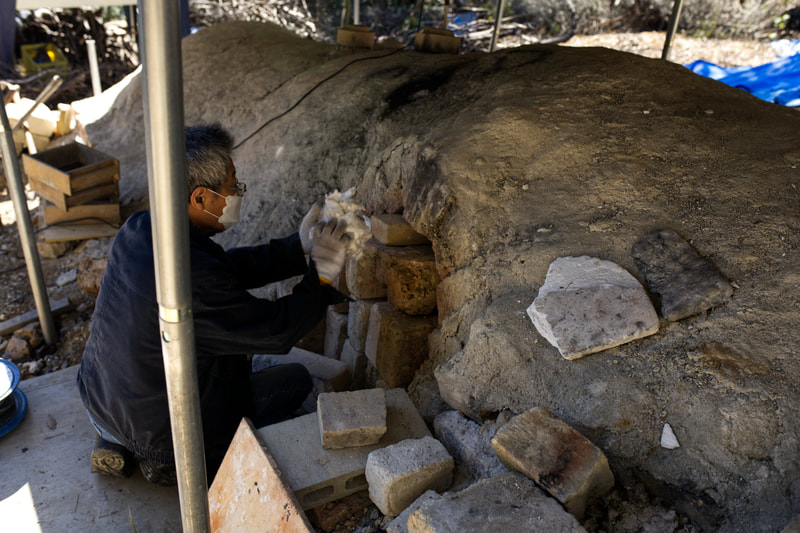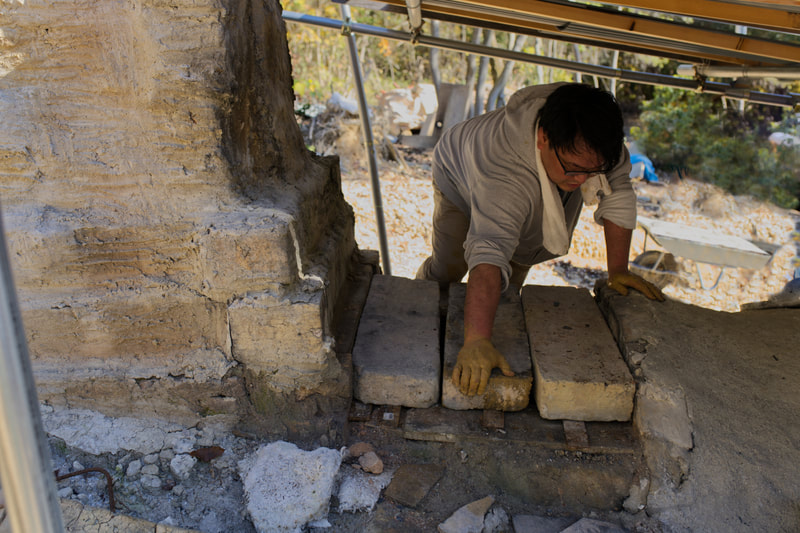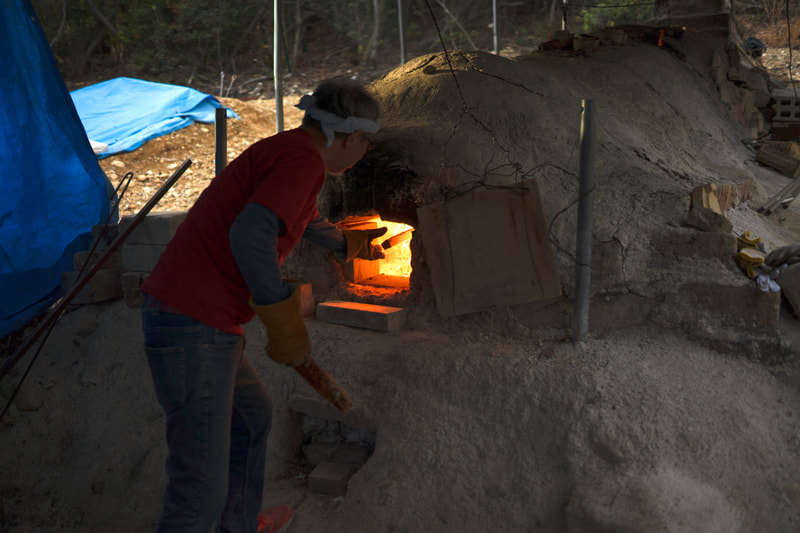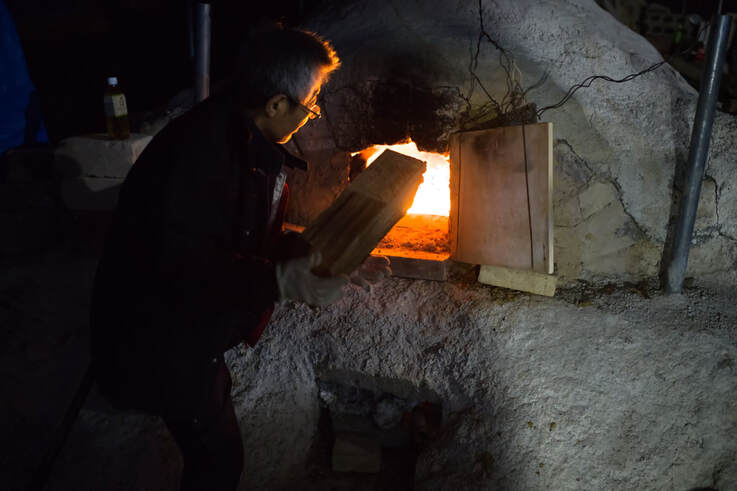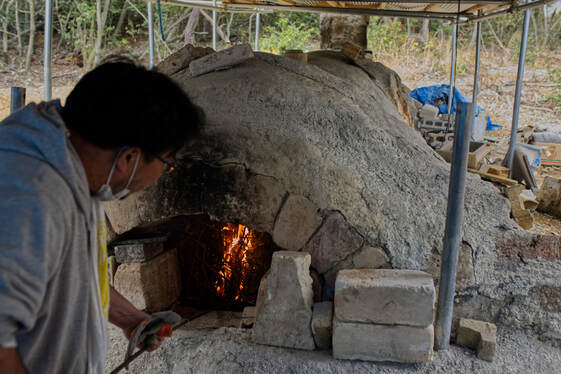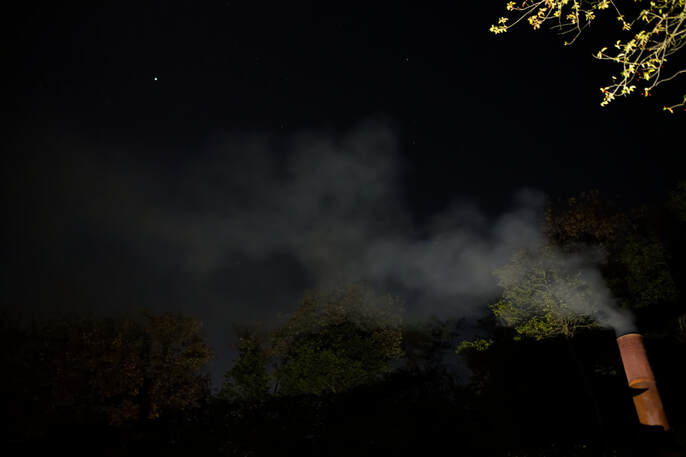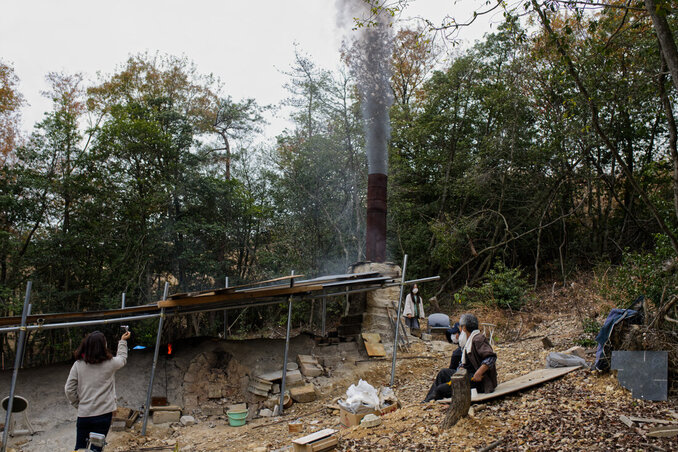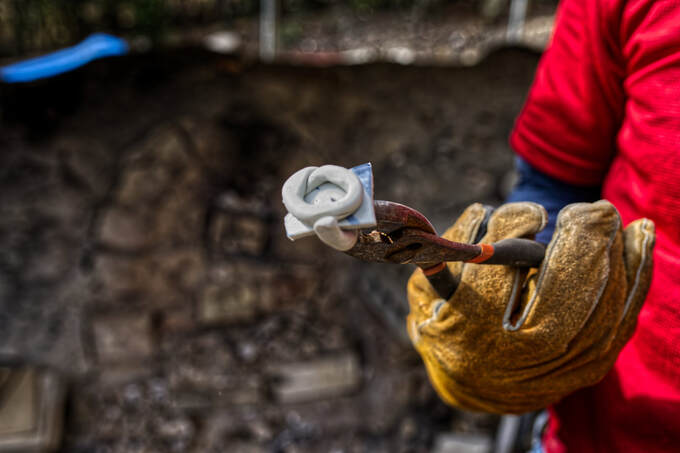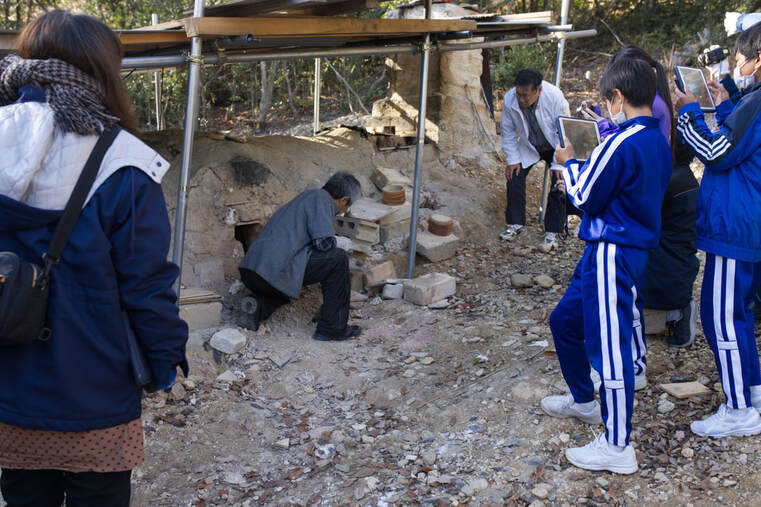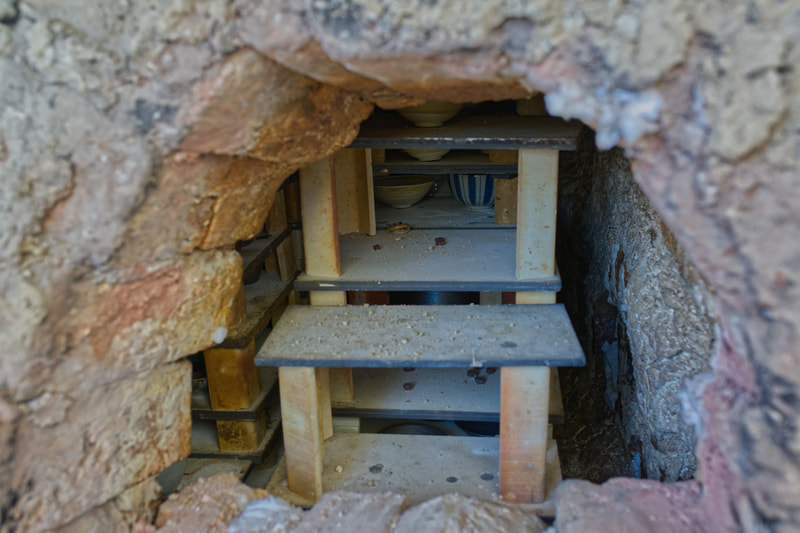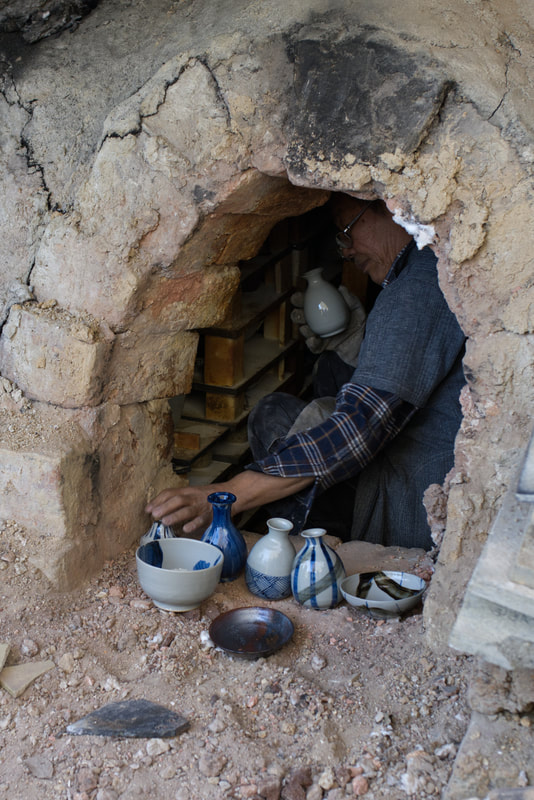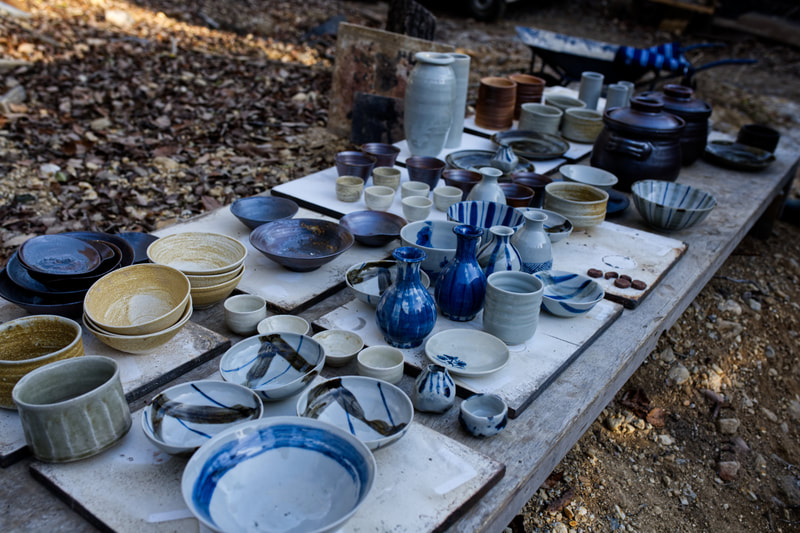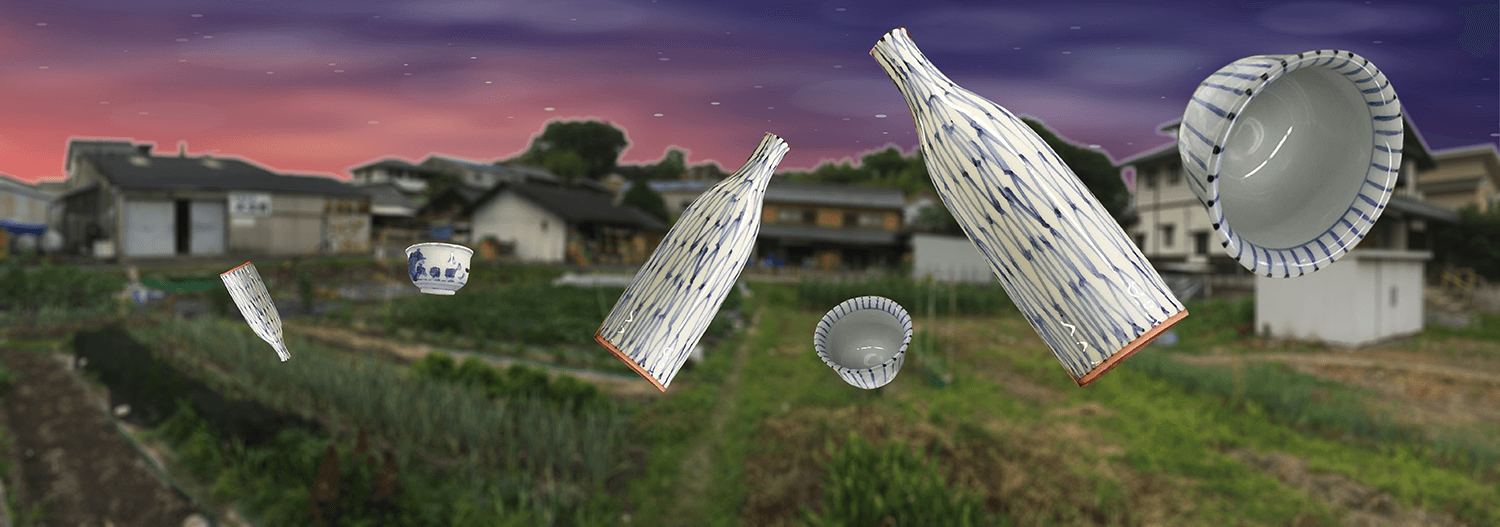A Muromachi Style Kiln Firing
Attempting to Recreate Shiro Tenmoku Tea Bowls the Medieval Way
By Hans Karlsson
One day in December 2022, I went up a hill near my house in Onada-cho, Tajimi City, to talk with potter Soukei Aoyama. While sitting in the sun next to the kiln that Aoyama had built, I listened to his many stories. He reproduced a Muromachi period (1336–1573) "Shiro tenmoku" (white tenmoku) tea bowl and was certified as an intangible cultural property holder by Tajimi City in 2018. To return to the origins of this ceramic tradition, he opened his own kiln, modelled after the kilns of the Muromachi period when Shiro-tenmoku was made.
This is a 3D model of the Shiro tenmoku courtesy of Mimir LLC. Move the model around freely with your mouse. Use the Alt or Option key to move the light. Aoyama-sensei has reengineered the production method of these tea bowls, but now he is taking this a step further by building a kiln of the kind that was probably used to fire them, to come even closer to the look of the originals.
The large belly-like chamber of the kiln cooled down after the five-day firing was completed, allowing the pottery inside to be removed. This endeavour required a significant amount of effort. The potters fought sleepiness as they continued to firewood into the massive anagama kiln on cold winter nights in Tajimi. It's been two years since the first kiln brick was produced.
It has been a difficult journey from beginning to end. I was permitted to assist in the cutting and splitting of several tonnes of wood. Kiln firing is much more difficult than I had anticipated, and seeing it up close taught me a lot.
The kiln is located in Kokeisan-cho, which is easily accessible by bus or bicycle from Tajimi Station (link to bicycle article). There are some good restaurants and cafes in the area, and the Eihoji Zen Temple, which has a long history, is not far away. If you are interested, you can find more information at the end of this article.
The pottery you see in galleries and stores is the end result of a long and laborious process that is both fascinating and instructive, especially when it is the culmination of the hard work required for a wood fired kiln. Aoyama has spent a significant part of his life restoring the shiro-tenmoku made in this region (read more about shiro-tenmoku and its history here). This article documents the first firing on November 29, 2022, in a project that began two years ago with the construction of bricks to build the kiln.
Loading and firing the kiln
The following is an overview of the kiln firing, which took place over 10 days.
November 28, 29, and 30
Loading of pottery into the kiln
December 1
Kiln loading ends at 6:00 a.m. The kiln is fired at a low temperature of about 200 degrees Celsius (392 Fahrenheit).
December 2
By the morning of this day, the temperature had reached about 400 degrees. The temperature was then slowly raised to around 750 degrees and held at that temperature.
December 3
A strong reduction is applied starting at 3:00 p.m. The temperature of the reduction starts at about 900 degrees. Eventually, the temperature is raised to 1,200 degrees.
December 4
At 3:00 p.m., an iromi test sample is pulled out to see how the glaze is doing. The ash glaze is not dissolved, and the dye is not dissolved enough, so more wood is burned.
December 5
The fire was extinguished around 10:00 a.m. The kiln begins cooling.
December 10
The pottery is removed from the kiln.
Loading of pottery into the kiln
December 1
Kiln loading ends at 6:00 a.m. The kiln is fired at a low temperature of about 200 degrees Celsius (392 Fahrenheit).
December 2
By the morning of this day, the temperature had reached about 400 degrees. The temperature was then slowly raised to around 750 degrees and held at that temperature.
December 3
A strong reduction is applied starting at 3:00 p.m. The temperature of the reduction starts at about 900 degrees. Eventually, the temperature is raised to 1,200 degrees.
December 4
At 3:00 p.m., an iromi test sample is pulled out to see how the glaze is doing. The ash glaze is not dissolved, and the dye is not dissolved enough, so more wood is burned.
December 5
The fire was extinguished around 10:00 a.m. The kiln begins cooling.
December 10
The pottery is removed from the kiln.
Master Aoyama uses reduction firing, that is, firing with less oxygen in the kiln. Carbon monoxide, a gas that is produced when more fuel is added than can be burned by air, deprives materials of oxygen when the temperature is raised. It robs oxygen from the clay and glaze. As a result, the pottery takes on a distinctive color.
Reduction firing is supposed to start at about 900 degrees Celsius, but would the kiln behave as expected? For this firing, Aoyama and his son, Kensuke, stacked and packed about 150 pieces of pottery, including about 50 pieces of Shiro tenmoku, on shelves inside the kiln.
The kiln is about 7 meters long, from the firing box at the bottom of the slope to the top, where the damper and chimney are located. Father and son began loading the kiln on November 28 and finished on December 1, the day of the firing. "A wild boar came up to us and was squealing!" Mr. Aoyama joked. Several times during the five days of kiln firing, the boars came to check on them. Kensuke, who had only slept a few hours the night before, appeared exhausted on the morning of the firing on December 1. The firing takes several days to reach the reduction level. First, the kiln's moisture must be removed, or the glaze will peel.
Kensuke began gathering thin branches from the wood on the hillside and was about to light the fire. The branches were moistened from the rain earlier in the autumn, and it looked as if he was having a little trouble getting the fire started, but he managed to light it successfully. On the first day of firing, the potters tried to keep the kiln temperature low and constant in order to dry out the dampness from the pottery and their enguro cases. Firing is not a matter of raising the temperature all at once; it is necessary to raise the temperature in stages. After searing the kiln at a low temperature of about 100 to 200 degrees, more wood is added, and the temperature is raised to about 750 degrees. Then that temperature is maintained. "This is what we call 'pulling the fire,' " Aoyama explained. We need to keep the temperature flat.
Then, on the fourth day, the kiln was heated to a reduction firing temperature of 1,200 degrees Celsius. Each type of pottery reacts differently to this process. Ash-glazed pottery, for example, requires a much longer firing time than other pieces. Aoyama says that Seto-guro (Black Seto) pieces are done first.
"We take a sample of the Seto-guro first, before the others," he says. The kiln is hotter under the ceiling than on the floor. For example, if you take a piece from the bottom and the glaze looks like it's melting properly, you know it's safe to take the piece from the top layer. "So I keep an eye on the pieces on the bottom and adjust the heat according to how the process is going and the colour of the piece."
He also uses small samples, called "iromi," which he can easily take out to check the condition of the glaze. He opened the door of the kiln, and we were allowed to see the fire inside for the first time. The fire was now at full blast. To be honest, I had imagined a blazing inferno, but the reality was quite different. It was like nothing I had ever seen before: a slow-moving, multi-layered, hot orange liquid. It should have been intensely hot, but strangely, I didn't feel much heat from where I was.
The Shiro tenmoku, which are housed in museums and other places today as great masterpieces, have been carefully handed down for 500 years and were used by warriors and others in the societal elite. One of them, Takeno Joo (1502-1555), is said to have first highlighted the beauty of Shiro tenmoku tea bowls. The bowls that Aoyama is firing in his kiln this time may turn out to be almost indistinguishable from the existing great masterpieces! This time, he used a clay similar to that found in the Shiro tenmoku shards found in the precincts of Hakusan Shrine in Onada Town. Expectations are high, but how will pieces turn out?
About the results
It is the fifth day since the fire was shut down. When I climbed the hill to visit the kiln, many people had already gathered. Many students in blue and white striped sports uniforms were also there. They had prepared tablets and cameras to capture the moment of opening the kiln. Mr. Aoyama was just about to remove the bricks blocking the entrance next to the kiln in order to open it. Did the tea bowls come out right?
It has taken a lot of time to prepare the kiln so far. For the past 20 years, the master has devoted himself to reproducing Shiro tenmoku and its process. The venue was filled with excitement as various thoughts came to the hearts of everyone who had witnessed the process up to this point. After a while, Mr. Aoyama removed the bricks from the entrance and began to take out the first pieces from the shelves inside.
Tall vases, sake vessels, and some underglaze white and blue pottery, among many other types of pottery, could be seen. Some of the pieces seemed to have stuck to the shelves, but overall they look fine. Aoyama has carefully chosen a number of these pieces to show at the upcoming exhibition. I'm interested to see how the Shiro tenmoku turned out, but they haven't been taken out yet. It's a breathtaking moment.
Unfortunately, there was not a single piece that had the colouring of classic Shiro tenmoku. The green glaze on the bottom of the bowl has not turned a deep green color. Mr. Aoyama took out a tenmoku tea bowl and scrutinized it. To show the difference, he placed a piece of a bowl excavated from an old kiln on the bottom of the finished bowl. "There are bubbles in the glaze like in the old shard, but the colour is different," he said. "This bowl is of poor quality, and I suspect it is due to the clay." It seems to be less pure than the clay I use. Also, it contains too little of certain substances, such as iron oxide."
Aoyama's research is not over yet. "Where is the optimal soil?" he wonders. "Shiro tenmoku was made in this area, so it has to be somewhere around here." "Can't you mix in a little more iron?" I ask. "No, it doesn't work like that." "Maybe we can make a phone call back to the potters of the Muromachi period and ask them." I joke. "No, the land has changed a lot in the last 500 years," he replies with a laugh.
What was going on inside the kiln? According to Mr. Aoyama, reduction occurred on the right side of the kiln and oxidation on the left side. That was a problem. It seems that he needs further ingenuity in the design of the kiln and in the preparation of the raw materials for the vessels. "I am not there yet, but I know I am on the right path. "I have only a few steps left in this long journey, but the last step is the hardest." "And now I am really ...tired..."
The master dozed off as we chatted in the warm sunshine by the kiln's chimney. Four days and three nights of working in the mountain must be exhausting.
Mimir LLC captured the choshingama kiln in 3D before the roof was erected.
ACCESS INFORMATION
kusanokashiragama kiln
Master Aoyama's kiln, Kusanokashiragama, is located in Onada, a neighboring village to Kokeisan village, where the Choshingama is located.
The Choshingama Kiln
The road leading up to the kiln was not yet marked on the map at the time of this writing. However, you will easily find the kiln by first going to the cafe nearby called Sandor. Walk up the road to the left of the cafe, and it will end up in a gravel road. Continue on the gravel road up the hill for about two hundred meters and you will find the Choshingama kiln.
Access by bus
There is a nearby bus stop Takataguchi from where you can walk to the Choshingama in about five minutes. The bus runs from Tajimi Station. Walk back in the opposite direction as the bus runs and turn to the right up the hill past the Sandor Cafe (see above).
Access by bicycle
There is a bicycle rental service in Tajimi where you can rent electric and standard bicycles for convenient mobility in the city. The Choshingama kiln is located about 20 minutes ride from the rental service by the JR Tajimi train station in the city centre.
There is a nearby bus stop Takataguchi from where you can walk to the Choshingama in about five minutes. The bus runs from Tajimi Station. Walk back in the opposite direction as the bus runs and turn to the right up the hill past the Sandor Cafe (see above).
Access by bicycle
There is a bicycle rental service in Tajimi where you can rent electric and standard bicycles for convenient mobility in the city. The Choshingama kiln is located about 20 minutes ride from the rental service by the JR Tajimi train station in the city centre.
RELATED ARTICLES
The Story of Mino ware (article series in five parts)
Shiro tenmoku (article series in two parts)
The roots of the Mino ware renaissance
Shiro tenmoku (article series in two parts)
The roots of the Mino ware renaissance
